#Grant Research
Text
Unlocking Opportunities: The Art of Grant Research for Your Organization
Introduction
Grants can be a valuable source of funding for organizations looking to support their projects, initiatives, and operations. However, finding the right grant opportunities can be a daunting task, requiring careful research, strategic planning, and effective execution. In this guide, we will explore the art of grant research, providing insights, tips, and strategies to help your organization unlock opportunities and secure the funding it needs.

Understanding the Importance of Grant Research
Grant research is the foundation of successful grant-seeking efforts. It involves identifying potential grant opportunities that align with your organization's mission, goals, and funding needs. Here are several reasons why grant research is crucial:
Maximizing Funding Potential: Conducting thorough grant research allows organizations to identify a wide range of funding opportunities, maximizing their chances of securing financial support for their projects and initiatives.
Aligning with Organizational Goals: By carefully selecting grants that align with their mission and objectives, organizations can ensure that the funding they receive will contribute to their strategic priorities and long-term sustainability.
Building Relationships: Grant research provides organizations with the opportunity to connect with grantmakers, funders, and philanthropic organizations, building relationships and partnerships that can lead to future funding opportunities and collaborations.
Staying Informed: Keeping abreast of the latest grant opportunities and trends in philanthropy and funding allows organizations to stay informed and proactive in their grant-seeking efforts, ensuring they are well-positioned to seize opportunities as they arise.
Key Steps in Grant Research
Effective grant research requires a systematic approach and attention to detail. Here are the key steps involved in the grant research process:
Define Your Funding Needs: Start by clearly defining your organization's funding needs, priorities, and objectives. Consider the specific projects, initiatives, or programs you are seeking funding for, as well as your target funding amount and timeline.
Identify Funding Sources: Conduct research to identify potential funding sources, including government agencies, foundations, corporate giving programs, and philanthropic organizations. Use online databases, grant directories, and funding websites to explore grant opportunities.
Refine Your Search Criteria: Narrow down your search criteria based on factors such as funding focus areas, geographic preferences, eligibility requirements, and funding priorities. This will help you identify grants that are the best fit for your organization.
Utilize Online Resources: Leverage online resources and databases to search for grant opportunities relevant to your organization's mission and objectives. Websites such as Grants.gov, Foundation Directory Online, and GuideStar offer comprehensive databases of grant opportunities.
Review Grant Guidelines: Once you have identified potential grant opportunities, carefully review the grant guidelines, eligibility criteria, and application requirements. Pay attention to deadlines, funding priorities, and any specific instructions for applicants.
Reach Out to Grantmakers: Consider reaching out to grantmakers directly to inquire about their funding priorities, application process, and any additional information they may require. Building relationships with grantmakers can help you better understand their funding priorities and increase your chances of success.
Strategies for Success in Grant Research
Successfully navigating the grant research process requires strategic planning, persistence, and attention to detail. Here are some strategies for success:
Be Proactive: Stay proactive in your grant research efforts by regularly checking online databases, subscribing to grant alerts, and networking with other organizations in your field. Set aside dedicated time each week for grant research and prospecting.
Focus on Quality over Quantity: Instead of casting a wide net and applying to every grant opportunity you come across, focus on identifying high-quality grant opportunities that align closely with your organization's mission, goals, and funding needs.
Tailor Your Approach: Customize your grant research approach to match the unique characteristics and priorities of your organization. Consider factors such as your organization's size, geographic location, target population, and funding history when identifying potential grant opportunities.
Stay Organized: Keep detailed records of your grant research activities, including information about potential funding sources, application deadlines, contact details, and application requirements. Use spreadsheets, databases, or project management tools to stay organized and track your progress.
Seek Feedback: Seek feedback from colleagues, mentors, or peers on your grant research strategy and approach. They can provide valuable insights, perspectives, and suggestions for improving your grant-seeking efforts.
Conclusion
Grant research is a critical component of successful grant-seeking efforts for organizations seeking funding for their projects, initiatives, and operations. By understanding the importance of grant research, following key steps in the research process, and implementing strategies for success, organizations can unlock opportunities and secure the funding they need to achieve their mission and goals. Remember to stay proactive, focus on quality over quantity, tailor your approach to match your organization's unique characteristics, stay organized, and seek feedback from peers and colleagues. With dedication, persistence, and strategic planning, your organization can navigate the art of grant research and position itself for funding success.
0 notes
Text
Dana riset minim, bukan alasan!

Banyak peneliti yang selalu mengeluh bahwa dana riset yang tersedia sangat minim untuk menghasilkan riset yang unggul atau berdampak luar biasa.
Stop complaining!
Itu hanya alasan bagi yang malas dan akhirnya menjadi alibi yang umum banyak peneliti. Di tengah keterbatasan, banyak peneliti yang kemudian menjadi lebih kreatif dalam berkarya.
UUD, ujung-ujungnya duit, betul!. Untuk riset peneliti butuh dana. Tapi kalau dana minim bukan lagi alibi yang tepat di jaman sekarang. Dana riset yang tersedia cukup melimpah. Dari yang orde-nya 50 juta sampai 2 M juga ada. Its’ a matter of being competitive. Waktunya kita menjadi pemain. Bukan lagi hanya menunggu disuapi.
Saya mengambil contoh di Eropa, Prof. yang tidak mendapatkan grant untuk penelitian tidak akan memiliki tim riset dan ujung-ujungnya lab akan ditutup. Sangat bertolak belakang dengan kondisi yang terjadi di tanah air.
Beberapa kondisi klasik lainnya adalah track record. Banyak peneliti yang memilih untuk menjadi opportunis dibandingkan dengan membangun expertise dari track record yang konsisten.
@jumalahmad
0 notes
Text
my favorite genre of character is autistic scientist with a transgender gait
#ben rambles#lets see who all i can tag this as#newt geiszler#hermann gottlieb#ford pines#herbert west#emmett brown#alphys#otto octavius#ian malcolm#alan grant#ellie sattler#the whole jp gang#ok that’s good enough. Might add more later heart wmoji#researcher talloran#dr grey
455 notes
·
View notes
Text



various karl and esther drawings :') netflix give them back to me PLEASE i don't want to keep going without them
#what's worse than a child's forgiveness? when it feels unearned. comic based off the mp100 scene ofc#and also a little special thanks to dearheartdont telling me about ration coupons and such!!#doing period research is always so interesting my jaw actually dropped when i realised you would have to PAY as well as give coupons--#--for new clothes. i take uniqlo for granted .#karl weissman#charles whiteman#esther jankovsky#my art#bodies netflix#sorry everyone i think im overthinking the bar scene where whiteman goes 'one good thing'#i do think he believes its the like. /literally/ the only good thing he's done. dies with that on his mind. GOD#and the amount of times he's called by his birth name and the terrible surprise on his face when mannix says 'karl weissman' .#he's just constantly going thru it
291 notes
·
View notes
Text
His eye isn't red.
I don't know if it's just the Tumblr algorithm is getting messed up or if there is a sudden uptick in this but...
Stop drawing Jake with a red eye. I don't care how funny or pretty or deep your art is. If Jake's got a red eye, I'm not reblogging it.
I'm also seeing an uptick in art of the boys doing Jewish things, which is very nice... But some of it is not well researched and is very inappropriate or just misinformed.
There are not six candles on a Menorah. Steven is not going to be dressed like a Rabbi. They also don't worship Khonshu. Not even Jake. Jake isn't going to run around murdering people for funzies.
Please... This fandom has suffered so long from lack of content. I appreciate the amazing art and so on... But don't feed into this just for views or because you think you saw red reflected out of his eye or someone said they did.
Give me content I can love wholeheartedly, share with others, and perhaps even purchase if you are selling.
#Moon Knight#Stop perpetuating the idea of an evil alter#Stop unwittingly feeding the fire#It takes two seconds to Google what a menorah looks like#Just do a little research#Jake Lockely#Marc Spector#Steven Grant
153 notes
·
View notes
Text
9-1-1 characters as sharks❕🦈
As a shark nerd, I had to. Enjoy! :)

1 - ✭ Bobby ; angel shark
• They spend most of their time hiding in mud and dust
2 - ✭ Athena ; leopard shark
• Their rough skin makes it hard for stuff to settle on them.

3 - ✭ May ; zebra shark
• As they mature, their stripes fade and then become small dark spots, which is why they are often mistaken for leopard sharks
4 - ✭ Hen ; mako shark
• They are very fast and smart sharks

5 - ✭ Karen ; silky shark
• They have a great hearing
6 - ✭ Chimney ; spiny dogfish shark
• They’re quite small

7 - ✭ Maddie ; blue shark
• They will attack if they feel threatened
8 - ✭ Daniel ; whale shark
• Only 10% of whale sharks make it to adulthood

9 - ✭ Buck ; lemon shark
• They are very loyal to their home, are highly social and can be jealous of other lemon sharks. They’ve also been known to help out humans who are lost and in danger
10 - ✭ Eddie ; white tip shark
• They swim away when swimmers or divers approach

11 - ✭ Ravi ; nurse shark
• Really friendly and social
12 - ✭ Albert ; bluntnose six gills shark
• Their ability to handle a variety of temperatures and depths allows them to go wherever they like

13 - ✭ Lucy ; megalodon
• There’s still a lot we don’t know about them
14 - ✭ Josh ; horn shark
• They have a tough exterior and sharp spines to protect themselves
—————
The end 🦈🌊 Thank you for reading <3
#did this for twitter in the first place but the autism was too strong#had to post it here too#the research part took SO LONG#i really wanted to find accurate stuff#hope i did#911#9-1-1#911 on abc#911 abc#bobby nash#athena grant#may grant#hen wilson#karen wilson#chimney han#maddie buckley#daniel buckley#evan buckley#eddie diaz#ravi panikkar#albert han#lucy donato#josh russo#sharks#i love sharks#like really REALLY love them
75 notes
·
View notes
Note
Ask meme - 6 and 9 for the dragon men (zhongli and neuvillette) please!
This took so long I am so sorry, but here we go!
[Character Analysis Ask Meme]
What is Neuvillette's biggest insecurity?
Neuvillette’s biggest insecurity is not something he's ever tried to hide. Anyone that has spent enough time with the Iudex has probably heard him mention it before. Simply put, Neuvillette doesn't understand the emotions of humans very well. He never has and sometimes he doubts if he ever will? How many times has this flaw of his costed him dearly in the past? How many mistakes has he made? And how many are there yet to come? How he dreads the thought.
What can’t you trust [Neuvillette] with?
To chase after you - Iudex Neuvillette is many things—polite, kind, intelligent—but he is not a man without faults. Only a few know him well enough to realize he holds many regrets upon his shoulders, majority that were never his burden alone to bear. Should you ever become the source of one of these regrets, you can surely expect to know. With somber eyes and a weight upon his shoulders, he will apologize to you. But don’t expect anymore than that. Not understanding human emotions is not only his weakness, but a prison. He will not attempt to make things up to you nor will he try to make things how they used to be. You’re best off where he can hurt you no more, even if that means he will be left alone to the rain.
What is Zhongli's biggest insecurity?
Who knows lol.
What can’t you trust Zhongli with?
With mora - As knowledgeable and talented Zhongli is with many things, it is a surprise to many to hear that businessmen don’t exactly enjoy making deals with him. How can they when contract discussions always leave them with the [shorter end of the stick]? How many [unforeseen business expenses] do they end up incurring in such a short amount of time? In the end, they always lose more than they gained. What they don’t know is this unfortunate occurrence happens with any Mora dealings with the man. But what can you expect for someone that, by contract, has the Traveler liable for all expenses during his outings with them? It's simply best to leave all matters of mora out of any relationships with him.
With your heart - If there's one thing true about Zhongli, it's that, while he may withhold the truth, he does not lie. So when he speaks of a person warmly, they can very well believe his words to be true. That being said, it is important that one does not mistaken his warmth with depth. One cannot simply entrust their heart to him and expect his in return. How could anyone hope to understand the weight of many a millennia, after all? So while the desire may be cute, it'll never be something he would even consider to reciprocate.
#genshin impact#genshin x reader#zhongli#neuvilllette#zhongli x reader#neuvillette x reader#character analysis ask meme#my writing#i am so sorry this took so long anon i have no excuses#not the happiest with these set of responses either#neuvillette’s insecurity answer is severely lacking#it’s so obvious that it feels too easy but like#the reason why i feel that way is because the answer doesn’t answer WHY tha5 is his biggest insecurity. WHY does it matter to him so much?#the obvious answer is that it is because he cares about humans but why??#the answer i came to is that deep down he wants to be accepted by humans which is why he seeks to understand them but i am not sure#granted that’s just my gut answer. i need to do way more research but i already left you waiting too long#as for zhongli like….. ugh#my first answer for what you can trust him with was a cop out but like!!!#that’s because my second answer is like something i talk about alllll the time when i talk about zhongli OTL#i have a whole series surrounding it orz#i didn’t think anyone would want me to talk about it again so i came up with the cop out answer#but the cop out answer was such a cop out i ended up typing my original idea haha#so you get two answers that are kind of mediocre. i’m sorry. ;v;#all of my other answers for him would be more humorous#you can’t trust him with: common sense… bringing appropriate party cups… arriving to events on time#tho there’s no proof for it you gotta admit that he gives off the vibes of someone tha5 is chronically late to everything#and as for his insecurity like… typically old and ‘spiritually actualized’ people are of the hardest to analyze in terms of insecurities#he has no chinks in his armor#i will be working on your next ask though! hopefully it takes less time ;v;
114 notes
·
View notes
Text
So, my brother and I watched Dinosaur (2000) relatively recently, and besides the fact that it's a bad movie with horrendous character design, one thing pissed him off more than anything else: the movie's use of the word "carnotaur".
Now, to him, this word was just an infuriating attempt at saying "carnivore", which in context, makes sense. What neither he nor I knew at the time is that this is not the case. Carnotaurs are real dinosaurs. And they're really cool.
Carnotaurus sastrei, the only one of its genus, is one of the few dinosaurs we have with some of its skin preserved. We know from those preservations that it had scales, which is one of the things we assume generally about dinosaurs that we have very little evidence for. Carnotaurs also were the only known carnivorous dinosaurs with horns, which is why it's named after a bull. The other half of its name (carno-) means "meaty", and even just looking at the skeleton, you can tell that it was one THICC ASS BOI.

I'm at least 90% certain this motherfucker looked like a sausage with teeth and thighs. We all clown on the T-Rex for its tiny arms, but look at this motherfucker. We're talking whale pelvis levels of vestigial here.
Another cool thing is that geographically, the movie having these as the main hunters makes more sense than having Tyrannosaurs. T-rex lived in what is now North America, whereas these death bratwurst lived in South America. We know that the asteroid that caused the extinction of the dinosaurs landed in the Gulf of Mexico, and given that we see in the movie that very asteroid hit the earth, I don't think it takes place in what would one day become California.
All this to say, Elliot, I know more about dinosaurs than you. Suck it.
#dinosaur#dinosaurs#carnotaurus#tyrannosaurus rex#t rex#disney#movies#dinosaur movies#late cretaceous#fossils#archaeology#paleontology#posting this because i have to defend this dogshit movie somehow because god dammit it wasnt that bad in some ways#granted the writing was awful and i hated every second any character was speaking#but at least the scenery is pretty and they did their goddamn research
223 notes
·
View notes
Text
Tropical Milkweed, Its Problems, and What To Plant Instead
I am writing this to atone for the sins of my past (handing out tropical milkweed cuttings to my friends and teachers before I knew better).
(Also let me make this clear I am Floridian I am writing this from the perspective of someone in the United States if you live in Tropical Milkweed's native range this doesn't apply to you go forth pogchamp)
Look online, on TV, in books, in newspapers, left, right, up, down, anywhere, and you'll see people talking about how planting milkweed is crucial, essential for the survival of monarch butterflies. Milkweed is the only plant that monarch caterpillars can eat as they're growing, and the loss of it in our wild spaces is one of the most direct links to the ecological extinction speedrun of not just monarchs, but dozens of other insects who rely on its abundance of nectar-filled flowers to survive. You'll be urged to run, not walk, to your nearest garden center, buy as much milkweed as you can, and hurry fast to plant it in your gardens and be part of the solution, not the problem. The issue is that, oftentimes, the milkweed you leave the store with is a vibrant red and orange, with pointed green leaves, dozens like it lining the shelves across stores all over the nation...
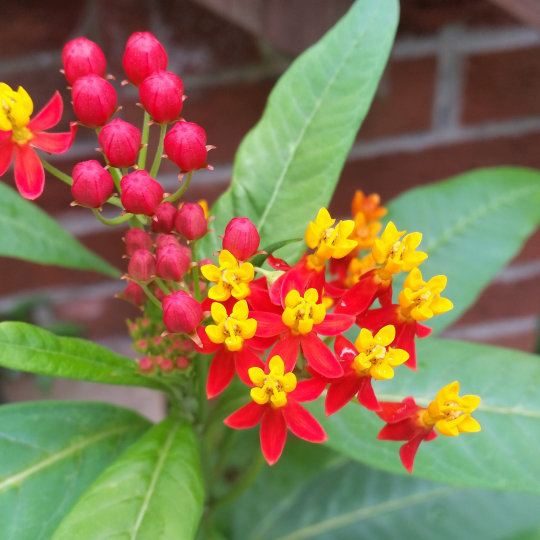
Tropical milkweed. Scarlet milkweed. Bloodflower. Mexican butterfly weed. Asclepias curassavica. This plant is a being of many names, and our culprit of the hour.
'Culprit? Culprit of what?' Culprit of enticing people to buy it under the guise of helping, only to possibly cause more harm than good.
Let's discuss.
Tropical Milkweed (Asclepias curassavica) is a gorgeous milkweed (especially the yellow variety? ooh, that had me in a grip as a teen) that's easy to obtain--too easy. It lines the shelves of stores like Walmart, Lowe's, Home Depot, and even hundreds and dozens of smaller garden stores, and is sold for reasonably cheap because its quick and easy to grow from seed and eagerly roots from cuttings. It's extremely popular with butterflies too--in many scenarios, Tropical Milkweed will be preferred as host plants over other related species like Butterflyweed (Asclepias tuberosa), and its also popular with other species of butterfly, bees, and wasps as a nectar source. It lasts well into winter in some areas of the United States, is quick to regrow when cut back, and doesn't die back for periods of the season like some other milkweeds do. It's eager to reseed, creating capsules with tens of dozens of seeds and scattering across the winds with the help of little silky parachutes much like the ones dandelions are known for.
'Ani, what's the problem with that? This all sounds like its great for monarchs!'
See, here's the kickers. In fact, here's several kickers. Here's an entire mollywhopping of kickers.
OE Infections
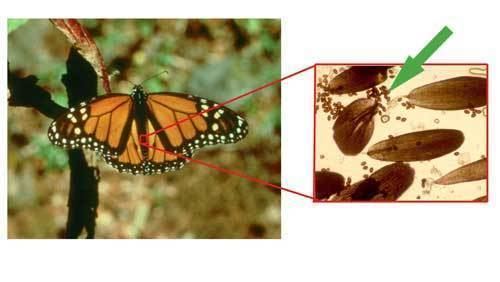
In the temperate areas that it doesn't die back over winter (or even, in some cases, where it doesn't die back during the season like other milkweeds), it can become a host for OE. OE is short for Ophryocystis elektroscirrha, and its a protozoan parasite that can and frequently does infect monarchs. As infected monarchs visit different plants--whether its to drink nectar, to lay eggs, or even just doing a fly-by of the garden--they drop spores from their wings that can then fall onto the leaves, flowers, and even any eggs already on the plant. As caterpillars hatch and begin to eat the plant, they ingest the protozoan, which begins the cycle anew. High OE levels in adult monarchs have been linked to lower migration success, reductions in body mass, lifespan, mating success, and flight ability. And that's if the caterpillars don't succumb prematurely to the infection, or if they're able to even exit their cocoon and fly once they finish pupating--deformed wings are frequently a result after infections. Now, OE is a parasite that's evolved alongside monarchs--and monarchs are usually able to handle an infection just fine, but if they're carrying a high load? That's where the problem lies.

What role does tropical milkweed play in this? Most milkweeds die back after blooming, at least once or even twice per season--and the parasite dies alongside them. As native milkweeds push out fresh foliage, its parasite-free, offering a healthy new buffet for caterpillars. Tropical milkweed... doesn't do that. If nothing's done, (at least in my state of Florida) tropical milkweed will stay fresh and green all the way up until the first real frost hits way in December--and that's if there's a hard frost, when you travel farther south. And during all that time, OE levels are building up on the leaves, so any future caterpillars that feed on this plant are doomed the instant their egg is laid on a leaf.
Its not that it's utterly impossible for a monarch to get infected with OE on any other kind of milkweed--monarchs are known for their traveling habits, and the chances of them happening upon a different milkweed plant than the tropical milkweed in your backyard is pretty high. But whereas native milkweeds die back and essentially reboot their system with fresh, disease-free leaves at least once a season, tropical milkweeds are like downloading a virus onto a USB and then passing it to your friends.
But that's not all, either. Time for kick 2.
Migration Interruption

Sit with me a moment and imagine you're a monarch butterfly. You're hardwired to know that as your food source starts dwindling at home, its time to get a move on and fly on down to the family's vacation home in Mexico for the winter. The buffets shut down, you exit stage left. But on your way to what's essentially a season-long smorgasbord with friends, you find... a buffet is still open. You're supposed to leave when the buffets are shutting down, but this one's up and running, lights are on, and plenty of people are there having fun, so you step in to relax. You'll take your trip later.
Now imagine a bit after you entered that buffet, the staff stuffed the guests into the walk-in freezer, locked the door, turned off all the lights, locked up the building, and left.
That's basically what tropical milkweed being 'evergreen' is doing to monarch butterflies in the fall and winter seasons. In areas up north where it can stay growing far later into the fall/winter months--or worse, in the south, where it can basically be evergreen until a hard frost (if one even happens), it can interrupt the monarchs' iconic migration cycle. They'll stay in place and continue breeding, living life like they aren't supposed to be a country away--until a frost hits, and they're dead in a snap. And if there's not a frost, you're getting a bunch of OE spore-ridden monarchs flying around a bunch of OE spore-ridden milkweed plants that the butterflies who followed the rules and overwintered in Mexico are gonna be returning to. POV you're starting a family in a house so laden with asbestos and black mold that there's practically black dust floating around.
This is already pretty bad. Can it get worse? Absolutely. Kick number 3.
It's Pretty Invasive (in the US)
It's fast growing, its eager to go to seed (so eager that it can flower and produce seed at the same time), its growing all throughout winter--which would be great, if it were native to the United States. Unfortunately, it isn't! As one could imply from the name, Mexican butterfly weed is native to--well--Mexico, as well as the Caribbean, South America, and Central America.
Further North into the states, and it's more of an annual--a plant that lasts maybe a year tops, dies back permanently, and you go buy more next year, or start from seed. Further south? It's a perennial, baby--which means its got even more time to spread its seeds and really thrive in the warmer climates of places like Florida, Texas, California, etc. Not to mention, as climate change makes temperatures rise, places where tropical milkweed is an annual may quickly begin seeing it stand strong all year...
I won't pretend to be a Professional Milkweed Identifier. I'm getting better at it with time, but I'm not a pro. But most of the time I go outside and I go 'oh, that's a milkweed!' its tropical milkweed. I've seen it grow in the sidewalk cracks of a gardening store I go to--its a clean four feet tall, always flowering, always making seeds. Tropical Milkweed is eager to escape the confines of your backyard, or make more plants in your backyard--I started with 5 plants one year, and the next year I had seven, then twelve, and that's just the ones that didn't get mowed over in the seedling stage...
But wait, that's not all! Kick number 4, baby!
Toxic to Monarchs????
According to the Xerces Foundation, emerging research suggests that tropical milkweed may become toxic to monarch caterpillars when exposed to the warmer temperatures associated with climate change.
'What the fuck, I thought milkweed was good for monarchs! How the hell does that happen?!'
All milkweeds produce cardenolides in their sap--a type of steroid that are toxic to most insects (and even people). Milkweeds create it to repel herbivores that would munch on it otherwise--except for milkweed butterflies (Danainae family), like our legendary monarch, as well as the queen and plain tiger butterfly. Larvae eat up milkweed leaves like there's no tomorrow, to stock up on those cardenolides and become toxic to their vertebrate predators--except for a few species that have evolved to become cardenolide-tolerant (black-backed orioles and black-headed grosbeaks). But, when cardenolide concentrations are high enough, it's too strong for even monarch butterflies to withstand--they die because of the very plant that's supposed to give them life. Kinda fucked up. Comparatively, many native species have lower cardenolide levels--and don't immediately go into flux at higher temps like tropical milkweed does.
'Wait, Ani, if there's all these problems with tropical milkweed, why is it sold everywhere?'
Capitalism. The answer is capitalism.
Well, actually, its a bit more complicated than that but it's also still capitalism.

The very same things that make tropical milkweed so invasive and such an issue are what make it so incredibly popular to sell. It's fast growing, and eagerly starts from cuttings as well as from seeds--which is perfect for growing tons of plants in quick and easy batches to send to vendors all over and get a quick profit. It's easy to grow from the home gardener too--its resistant to most diseases, looks gorgeous almost year-round, is quick to return in many areas without even the slightest sign of a die-back, and is popular with monarchs and other pollinators. Want to start a pollinator garden with quick results? Plant milkweed--and when tropical milkweed is all that you see available when you walk into your beloved store, it's what most people are going to get without thinking twice. Not to mention, when you hear it starts quick from cuttings, and you really wanna get your friends and loved ones into pollinator gardening, well... you get well-meaning people sharing invasive plants with their homies, like I did in high school. I've been pollinator gardening for around sixish-sevenish years (I think) and I didn't even catch wind that tropical milkweed was invasive until three years in! To say I was mortified doesn't describe it fully.
'Wait, three years ago? So information about this has been out awhile! Why aren't more places selling native milkweeds by now?! Why are people still buying this invasive milkweed and not native ones?!'
It's capitalism again! But in a different way.
Compared to tropical milkweed, many other milkweeds are a lot more... finnicky to get started, or grow in general. Many of them are a lot slower to germinate, are more prone to failing as seedlings and falling victim to things like 'dampening off' or 'too many aphid' or 'the vibes were wrong.' If they do germinate, they're slower to get to size too--I've grown tropical milkweed from seed in solo cups and gotten something about four inches tall within maybe a month and a half. Some other milkweeds I've grown from seed take about a month and a half to get more than four leaves, or even poke their little green heads out of the dirt. In addition to this, milkweeds have taproots--and some are a lot more friendly to the concept of 'transplanting from a pot to the ground' or 'growing in a pot at all' than others, and tropical milkweed ranks at the top of that list again. Not to mention, their willingness and ability to overwinter in pots--many native milkweeds fail that test, meaning that even if all the resources and efforts are put into getting a milkweed to grow from seed, it won't survive longer than a year in that pot. Considering most milkweeds don't flower until a year or so into their growth, and it's easier to sell plants that are flowering... many plants are a tough sell.
Another reason? Some native milkweeds are way more picky about when they want to make seed pods, or what conditions their seeds want to be grown in. If the seeds are hard to obtain? Good luck growing them in a production greenhouse. Let alone finding seeds for sale to grow them yourself at home--in my hunt for native milkweed species, I've seen packets of ten seeds sold for twenty bucks, packets of 25 seeds sold for anywhere from 50 to 100--meanwhile, you can find dozens if not hundreds of tropical milkweed seeds sold in a pack for maybe a dollar or five.
Let's be real. Producers haven't figured out the magic ticket to pumping out native milkweeds like they have with tropical milkweed--as such, finding native milkweeds for sale is rare, and they're often pricier. And as someone who's been to a native plant sale and found the stands sold out of milkweeds not even 30 minutes into the event--you are likely not the only person wanting native milkweeds. It is war out there in the garden parties.
And that's assuming you've actually found native milkweed for sale! As you get better with milkweed IDs, you'll be able to clearly identify the liars who are telling you they've got something that they don't, but for those who aren't In The Know--if you see a milkweed labeled like a native milkweed and want to buy native milkweed, it might be too late by the time you realize you just got sold tropical milkweed with a mislabel. Whether its on accident or on purpose, it still bites.
I've asked some of my favorite, smaller greenhouses if they'd be willing to start selling native milkweeds. Most of the time I get an exasperated 'I would love to.' But they can only sell what the vendors can produce--so if they can't find a vendor that's selling swamp milkweed (or at least reliably), then they can't give me swamp milkweed when I poke my head in asking if they have any in stock. Of all the times I've gone to dozens of different green houses and gardening events, in different cities even, to see if they have any native milkweeds I've only had success a few times--one small vendor who only has them in stock at events sometimes (and that's if I don't show up late), and the one time I rolled into a not-big-box-but-not-small gardening store near my friends house after being sad that I couldn't find it at a different gardening event. And the one I found there was the last one they had in stock for the next month or two. Until The Vendors get better at growing native milkweeds, your best bet is going to be growing it from seed yourself, getting a start from a friend, or dumb luck at smaller nurseries and events. It's rough out here, friends.
Granted! Keep in mind! That whole last paragraph was personal anecdotes. It's entirely possible that other places' greenhouses have already caught on, and I'm simply in the shadowlands where nobody's selling native milkweeds except for once or twice a year and selling out within 20 minutes of opening their damn booth. And I've heard tell of people getting milkweed popping up willingly in their backyards by doing things as simple as not mowing. I pray you have better luck than I do, young Padawan.
Now, keep in mind, there are people actively working on this. Whether its a team of university scientists dedicating themselves to a project, or a few home-growers in a sunny backyard and a greenhouse doing their damn best to grow native milkweeds as efficiently as possible for themselves and their friends, there are people working on this, sharing advice and communicating online. This isn't some unresolved issue that no one has noticed. We just... aren't at the end post yet. Until then, we scrounge for what we can.
'Oh no, oh god, I have a bunch of tropical milkweed plants in my garden!! Am I a bad person?!?!'
No You Are Not A Bad Person For Growing Tropical Milkweed
And I'm perfectly honest about that. Because I'm here telling you this and I've still got tropical milkweed plants in my backyard. As that one comic once said, about 10,000 people learn something new every day, and unfortunately today that 'new thing' is a bit sad and a bit untimely. In full honesty, oftentimes in my brain I refer to Tropical Milkweed as Starter Milkweed--its what a lot of pollinator gardeners end up starting with, because its just so available! But! There are things that you can do to mitigate the Damage that tropical milkweed can bring to your backyard butterflies.
Step One: Cut back your milkweeds! At least once a year, maybe even twice a year if you want. This will force them to put out new growth, which will be free of OE spores and give monarchs on it a good head start against the Disease. But for sure, for sure, cut your milkweeds back in the fall--once October hits, I go into the backyard and I snip down everything that's tropical milkweed. Usually at this point (at least for me), the milkweeds don't try to grow back again until spring. This is to prevent monarchs from seeing a buffet and getting locked in the freezer.
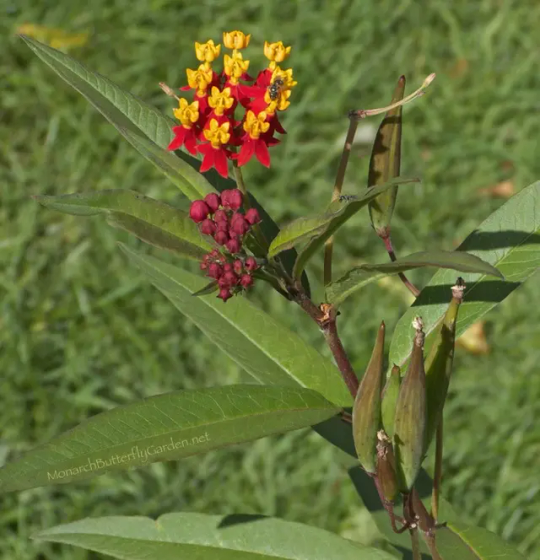
Step Two: Cut back seed pods! You would not believe how many seed pods milkweed makes. You see those little green footballs? You wanna snip these back ASAP. Even if they're tiny, but especially if they're bit. In peak flower production times, I'll go out there at least once a week and just do a look-back and cut them off. You can even yoink them off with your hands if you're in a rush--just don't get that sap into your eyes. If you do this, you're stopping seed production in its tracks--and don't forget, these plants want nothing more than to split those pods open and unleash a hellfire of flying seeds all over the place. They'll float on air, they'll float on water, they'll do whatever until they land on a prime patch of soil and get started.
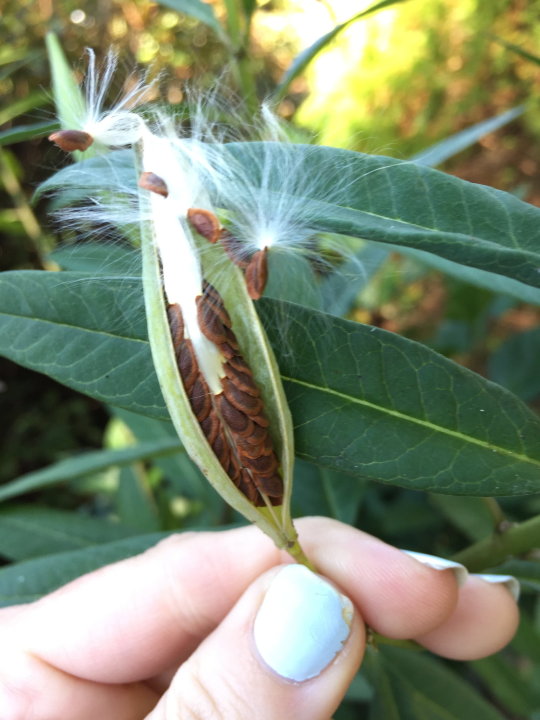
If you see these you're a tinge too late. But also still yoink that off and Dispose of it.
Step 3: Don't give cuttings to your friends. It's tempting. If you're raising caterpillars in a little enclosure and see that every time you refresh your cuttings, the old ones have tons of roots and are ready for a little pot of soil and a name tag? Don't. Resist the best you can. Dispose of your cuttings whenever you go in for a trim.
Step 4: Consider replacing them with something else! I know I already went off about just how hard it was to find native milkweeds for sale, how expensive and difficult they can be to grow--but they're not impossible to grow, and putting in the effort could be worth it! Even as I speak, I'm trying to add as many native milkweeds to my garden as possible--and when I've got something that grows reliably in my backyard, I will eagerly rip up my aging tropical milkweed plants and promptly toss them in the bin so i can put a new, better milkweed in its place. Native milkweeds are more likely to be suited to your environment, making it easier to maintain and more welcoming to the pollinators we gardeners want to help. Not to mention, a lot of them are way pettier than tropical milkweed (in my opinion). Do some hunting online to see what's native to your area--your state's extensions office will likely be great for this! You've likely got great variety--the state of Florida has 21 native milkweeds! Who knows how many your state has! (Not me, I am Floridian, and I am already getting dizzy trying to learn about all 21 of our milkweeds).
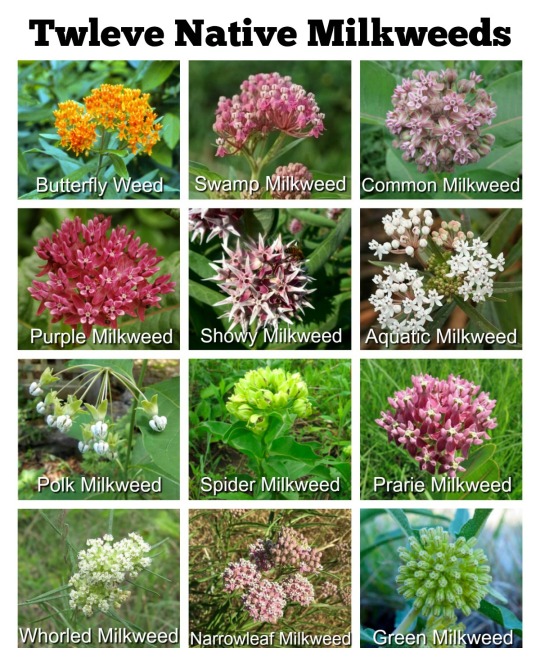
Conclusion!
Anyone who knows me knows I'm not gonna be the one to discourage someone from starting a garden, especially a pollinator gardener, and especially growing milkweed. But avoid tropical milkweed when you can--the harms it can cause far outweigh the quick satisfaction of a busy garden it can bring. Take some time to select a native plant more suited to your area, give it some friends and some time, and soon you'll have an amazing pollinator garden that'll be teeming with life!
#milkweed#tropical milkweed#asclepias curassavica#asclepias#outdoor gardening#succulents#bloodflower#pollinator garden#pollinator gardening#monarch butterfly#ani rambles#out of queue#what was it three hours ago that I was declaring that I wasn't gonna write up a long research post again?#now here i am at 3:30 am ranting about milkweed with like a dozen sources#granted this is nowhere NEAR as long as the biodiversity saga was BUT STILL#i told myself i was gonna write today... i meant one of my novels NOT RANTING ABOUT MILKWEED#if this post blows up this is gonna go on my wall of 'posts that i thought of on the toilet that got way more popular than I expected'#there's not a lot of posts on that wall maybe 2 or 3 but its weird that its happened that many times already
253 notes
·
View notes
Text


The Flash Suit went though quite a few changes over the years but which suit did you like best?
#the flash#barry allen#grant gustin#dctv#arrowverse#arrowverse suits#I kinda like s4 suit but like i can barely sit though that season#I'm so certain one of these won't get any votes I've prepared another poll for it lol#gold boots suit why you so difficult to get a full shot off?#This isn't even all the changes btw. From my research there may be one or two more that are only had minute changes I didn't add#cw the flash
39 notes
·
View notes
Text
Why Ratio isn't in Genius Society - theories
Nous regarded him and decided that he's doing fine without them.
Or because he isn't a genius. When he calls himself mediocre, it isn't a humblebrag. He's just a normal human with average intelligence. He achieved everything through hard work (in one of his character stories, his old professor talks about how, even as a kid, he'd wake up very early, exercise, and spend the whole day studying).
That's why he's often frustrated with his students. Like, guys, you are provided with all these opportunities to learn, you can surpass me, why are you squandering them? Or, I sacrificed my childhood and youth to science, why isn't everyone else willing to do the same? (turns out most people only become students to finally enjoy adult life away from their parents and maybe acquire some minimal knowledge and credentials to have a chance of a cushy job in the future.)
BTW, as a teacher, isn't he a self-made emanator of erudition? Not in a mystical Aeon-related sense, but literally—he spreads knowledge.
#honkai star rail#my stuff#dr ratio#granted this isn't how it works in real life#you can't study and do research 24/7 from childhood#unless you are really predisposed to it#or most likely abusive worthless parents are involved#trying to finally 'achieve' something through their child#and it usually doesn't end well for the child#although there is no indication of something dramatic like this#in Ratio's story#he probably did it voluntarily#and again this extreme overwhelming dedication#is the reason he's in Hunt and not Erudition
41 notes
·
View notes
Text
Since I've been talking about 'Wilson', I have one other thing to say about why it's an incredible episode that didn't really fit my last post. Out of all the amazing things about it, maybe my favourite is that we get to see Wilson lie. Obviously this isn't actually unusual. Wilson lies a lot. Maybe more than anyone else on the show?? He ranks highly on the Everybody Lies list, for sure. But in this episode, we see Wilson lying from Wilson's point of view, and it really drives home just how completely shameless and convincing he can be.
We know he's a good liar because he regularly deceives his human lie detector best friend - at least for a while, and when he's caught it's mostly discrepancies in the facts that give him away, not his poker face. But it's hard to fully appreciate it until you see him go directly from a conversation to lying about it. And here, we see him go from:
Wilson: You're moving in with Lucas?
Cuddy: Yes.
Wilson: [...] You want my blessing, and implicitly, House's blessing.
To:
House: What did [Cuddy] want?
Wilson: She was checking up on [the patient].
House: That's it?
Wilson: Like what? Something about you? Something you could interpret as being about you? An anagram maybe?
He accuses Cuddy to her face of having House-related ulterior motives in their conversation, and then turns around and ridicules House for thinking the same thing. He does it without flinching! He almost convinced me and I'd just watched the interaction that contradicted his words.
What I love about this is that it's not just a lie. It's passive aggressive manipulation. He sarcastically implies that House is narcissistic and deluded to sell it. I mean, he has to, because if it was true that's what he'd say and House wouldn't believe anything less. And it probably helps that Wilson's criticisms will roll right off House's back while hearing that Cuddy and Lucas are moving in together will hit a lot harder. He's lying to protect House, after all. But still, watching this and then thinking about all the other times he's lied effortlessly and without a second's hesitation makes me so passionately insane about him. The layers of doublethink going into maintaining his precarious honour code... I would fight House in a combat style of his choosing for the research grant to study Wilson's brain.
#house md#fable talks#(i wonder if the toxic homoerotic friendship comes free with the research grant or if i have to duel for that one separately)
64 notes
·
View notes
Text
i know as a garrus fan i can't really talk and i don't want to cause a whole Dilemma but the artwork for the mass effect board game is pissing me right off because it's so clear 90% of the effort went into liara and then everyone else is just tweaked screenshots and they claim there's no use of ai but shepard's face doesn't look right either or it's cut/pasted off something





#granted if it's called 'hagalaz' then surely it's about dealing with the shadow broker and thus liara is the actual centre of attention#but at that point why not just use screenshots. like either they hired a professional artist to make this and that's their outcome#and therefore like no creativity or research. or they cheaped out and got someone cheap who didn't have betterment resources#or something in between. or they got crunched. but just??? i know this is petty but it's just irritated me as an artist lol#especially considering this is endorsed/an official product and such like what happened#mass effect#edit: don't know why i typed 'betterment' but 🤷
46 notes
·
View notes
Text
Sometimes you just have to have a little cry in the middle of a bunch of 500 year-old books, and that's okay. I am telling myself it's okay.
#well. not all 500 year-old. but the oldest ones are#with the semester finishing up there's a grant ending at the historical medical library where i've been working#and they are having to reduce the number of student staff#i had a suspicion i was one of the people that wasn't getting asked to come back and. that appears to be true#and while i probably didn't do anything more wrong than anyone else and it almost certainly does come down to finances#it still feels bad#and i'm sad about it because i love it here#and like. it's okay. i'll be okay#i have another work study job in a different archive still#and with the research grant i got i'll still get to be in here a lot doing my own research#i am a stronger person than i used to be and i can take something like this a lot better than i would have when i was younger#but man. still need to have a cry about it
48 notes
·
View notes
Text



I managed to get the camera working. Fives wanted me to upload some pics of us.
-F. Mahony
#scp ocs#scp oc#scp foundation#scp fandom#scp#scp fanart#scp ask blog#site 523#dir soumare#dr rayner#dr moloch#dr grant#researcher newmaker#researcher othello#officer kiselyova#finn mahony#the site 523
30 notes
·
View notes
Text
Random headcanon I don’t think I’ve ever posted before: In the Pokémon world, language education encompasses the native language of the region and “common language” which can be spoken anywhere without much issue. The reason the protagonists can move across the world and still understand everyone perfectly is because people are speaking common language to them out of courtesy. When characters (Hau and Nemona for example) speak in slang or a different language, that’s fragments of the region’s native language they’re incorporating
#this is a small worldbuilding thing I’ve had for a while#relevant to my SV stuff bc I think Nemona isn’t very good at common and uses native Paldean everywhere except around the player#the professors spoke common bc of research and grants and stuff so Arven defaults to that#and penny is Galarian so she has to speak common#which is why only Nemona speaks Spanish out of the three#anyway.#mod vex#headcanons
68 notes
·
View notes